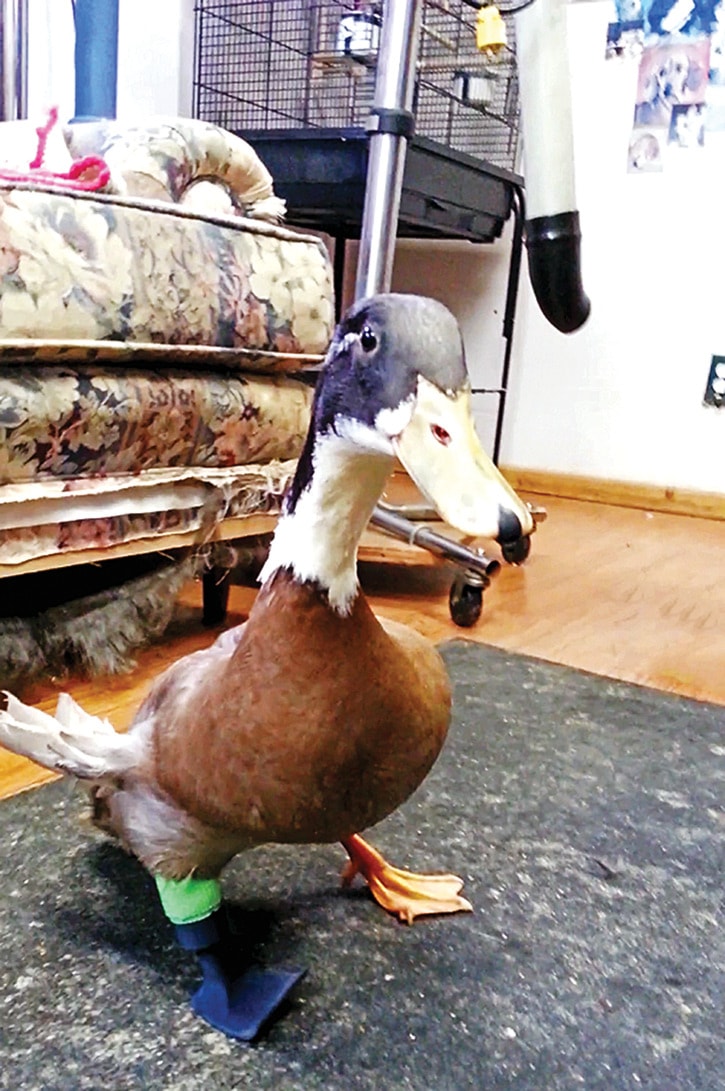Dudley has taken to walking on two legs like other ducks would to water.
On Wednesday, Dec. 18, Dudley the call duck’s right limb was fitted with a prosthetic leg and foot. By Friday, Dudley’s owner and caretaker, Debbie Fortin of K9-1-1 Animal Rescue and Services, said the little water fowl was walking on both legs as though he had them his whole life.
“He also thinks now that he has a leg, he can run away,” laughs Fortin. “When we go to get him now for his bath, because he still has to have rehab, instead of just sitting there and letting us pick him up, he’ll try and run away, and he’s very successful at it but he’s in a confined area. It’s really good to see that happen because before he couldn’t.”
Dudley lost his foot and part of his leg when he was a wee duckling. Not long after, Fortin’s son, Brandon Schweitzer contacted his friend Terence Loring, a mechanical engineer who recently started his own Kamloops-based company, 3 Pillar Designs. Loring specializes in 3D architecture and design and paid the duckling a visit, deciding to take on the challenge of designing a prosthetic leg.
Loring came up with a few different designs and two models, with the actual printing of prosthetics being done by Canadian company Proto3000. The first design was at a wrong angle and more complex than needed.
“I thought I’d try to make it very realistic, but it just made it super cumbersome, so I decided to go back to something very simple and build on that,” says Loring. “At least we got him walking, and if need be we can do something a little more complex. But at this point, at least he’s got his balance and everything.”
Loring and Proto3000 donated all of their time and materials for the project, for which Fortin is grateful.
Dudley is still getting used to moving on the new leg, with some surfaces and obstacles that he was used to going over with one leg posing a bit of a challenge. But, in general, Fortin says he’s getting around better and his health is improving as a result.
“He also now is using his wings more because he’s more upright so he’s able to flap them fully open,” says Fortin. “We had to clip his wings so he doesn’t fly, but he has his flight wings so he spreads them and flaps them because he can stand up and be like a real duck. He seems pretty proud.”
A remaining challenge is the fastening of the prosthetic to Dudley’s stub – something more secure is needed.
“We’re looking into a strap or something to hold the actual leg on his stump,” says Fortin. “That’s a transition we’re making too, but we’ve got several people trying to come up with ideas that won’t stop circulation… you can see it’s doable.”
When news of his humane design project broke, Loring said he received calls from other people with injured animals, including someone with an emu that had lost its leg. Loring was interested in taking on the project; however, due to other complications, the animal had to be put down. And while his curriculum vitae includes much larger design projects, Loring is enthusiastic about his work with Fortin and Dudley, and how he was able to have a positive impact on both their lives.
“A lot of people say it’s trivial, and in some ways it might be, but a lot of people really care for this little animal, so I guess that’s why I really wanted to take this on,” says Loring. “If they think it’s important enough, well, why not?”
As someone who cares for animals professionally, Fortin says her eyes are now wide open to the world of 3D printing and the potential benefits the technology can offer animals and humans alike.
“There’s lots of possibilities and I know we can’t look at funding those things because we don’t have the financial backing, but just knowing that it is possible to do that gives us a lot more insight as to what we can do,” says Fortin.
